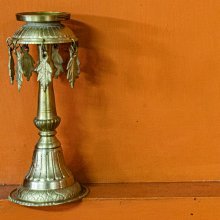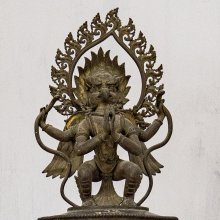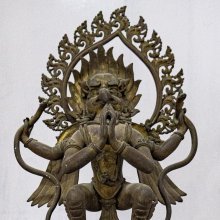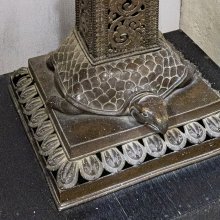Panasa: 27 definitions
Introduction:
Panasa means something in Hinduism, Sanskrit, Jainism, Prakrit, Buddhism, Pali, the history of ancient India, Marathi, biology. If you want to know the exact meaning, history, etymology or English translation of this term then check out the descriptions on this page. Add your comment or reference to a book if you want to contribute to this summary article.
Images (photo gallery)
In Hinduism
Natyashastra (theatrics and dramaturgy)
Source: archive.org: The mirror of gesture (abhinaya-darpana)One of the Hands indicating Trees.—Panasa (bread-fruit), the Catura hand;

Natyashastra (नाट्यशास्त्र, nāṭyaśāstra) refers to both the ancient Indian tradition (shastra) of performing arts, (natya—theatrics, drama, dance, music), as well as the name of a Sanskrit work dealing with these subjects. It also teaches the rules for composing Dramatic plays (nataka), construction and performance of Theater, and Poetic works (kavya).
Purana and Itihasa (epic history)
Source: archive.org: Puranic EncyclopediaPanasa (पनस).—A soldier of the army of monkeys of Śrī Rāma. This soldier was the commander-in-chief of an army of fiftyone crores of monkeys who fought against Rāvaṇa. His chief object of attack was the army of a demon named Paṭuśa. (Chapter 283, Vana Parva).
Source: Cologne Digital Sanskrit Dictionaries: The Purana IndexPanasa (पनस).—A Vānara, whose daughter was Rumā;1 followed Rāma in his expedition to Lankā.2

The Purana (पुराण, purāṇas) refers to Sanskrit literature preserving ancient India’s vast cultural history, including historical legends, religious ceremonies, various arts and sciences. The eighteen mahapuranas total over 400,000 shlokas (metrical couplets) and date to at least several centuries BCE.
Shaktism (Shakta philosophy)
Source: Wisdom Library: Śrīmad Devī BhāgavatamPanasa (पनस) is the name of a tree found in maṇidvīpa (Śakti’s abode), according to the Devī-bhāgavata-purāṇa 12.10. Accordingly, these trees always bear flowers, fruits and new leaves, and the sweet fragrance of their scent is spread across all the quarters in this place. The trees (e.g. Panasa) attract bees and birds of various species and rivers are seen flowing through their forests carrying many juicy liquids. Maṇidvīpa is defined as the home of Devī, built according to her will. It is compared with Sarvaloka, as it is superior to all other lokas.
The Devī-bhāgavata-purāṇa, or Śrīmad-devī-bhāgavatam, is categorised as a Mahāpurāṇa, a type of Sanskrit literature containing cultural information on ancient India, religious/spiritual prescriptions and a range of topics concerning the various arts and sciences. The whole text is composed of 18,000 metrical verses, possibly originating from before the 6th century.
Source: Addaiyan Journal of Arts, Humanities and Social Sciences: Tantra Literature of Kerala- Special Reference to MātṛsadbhāvaPanasa (पनस) or “jackfruit tree” refers to of the trees used for making Bimbas or Pratimās, according to the Mātṛsadbhāva, one of the earliest Śākta Tantras from Kerala.—Mātṛsadbhāva is a Kerala Tantric ritual manual dealing with the worship of Goddess Bhadrakālī (also known as Rurujit) along with sapta-mātṛs or Seven mothers. [...] There are many descriptions about the flora and fauna in Mātṛssadbhāva. [...] In the fourth chapter the author discussed about different types of trees [e.g., panasa] can be used to make pratimā or bimba.

Shakta (शाक्त, śākta) or Shaktism (śāktism) represents a tradition of Hinduism where the Goddess (Devi) is revered and worshipped. Shakta literature includes a range of scriptures, including various Agamas and Tantras, although its roots may be traced back to the Vedas.
Pancaratra (worship of Nārāyaṇa)
Source: archive.org: Isvara Samhita Vol 5Panasa (पनस) refers to the “jack fruits” and is used in oblation offerings, according to verse 25.137-141a of the 8th-century Īśvarasaṃhitā. Accordingly, “... they [eg., panasa] are already cooked, filling the cooking vessels (sthālī) and dishes (śarāva) are to be kept in all broad frying vessels (ambarīṣa). They are to be placed on vessels (pātra) smeared with (within) ghee (ghṛta), are hot and are to be spread out there. They which are heated and made greasy with powdered peppers, jīraka and ghee are to be stirred again and again with ladle. They are to be kept in vessels covered with clothes etc”.

Pancaratra (पाञ्चरात्र, pāñcarātra) represents a tradition of Hinduism where Narayana is revered and worshipped. Closeley related to Vaishnavism, the Pancaratra literature includes various Agamas and tantras incorporating many Vaishnava philosophies.
Ayurveda (science of life)
Dietetics and Culinary Art (such as household cooking)
Source: Shodhganga: Dietetics and culinary art in ancient and medieval IndiaPanasa (पनस) refers to the “jackfruit” and is mentioned in a list of potential causes for indigestion in the 17th century Bhojanakutūhala (dravyaguṇāguṇa-kathana), and is commonly found in literature dealing with the topics of dietetics and culinary art, also known as Pākaśāstra or Pākakalā.—A complete section in Bhojanakutūhala is devoted for the description of agents that cause indigestion [viz., panasa (jackfruit)]. These agents consumed on a large scale can cause indigestion for certain people. The remedies [viz., kadala (plantain) or sarjabīja (Terminalia tomentosa) or ārdrāmrabīja (fresh seed of mango)] for these types of indigestions are also explained therewith.

Āyurveda (आयुर्वेद, ayurveda) is a branch of Indian science dealing with medicine, herbalism, taxology, anatomy, surgery, alchemy and related topics. Traditional practice of Āyurveda in ancient India dates back to at least the first millenium BC. Literature is commonly written in Sanskrit using various poetic metres.
In Jainism
Jain philosophy
Source: archive.org: Anekanta Jaya Pataka of Haribhadra SuriPanasa (पनस) refers to the “jack-fruit tree”, as occurring in the Anekāntajayapatākā-prakaraṇa, a Śvetāmbara Jain philosophical work written by Haribhadra Sūri.—[Cf. Vol. I, P. 193, l. 15]—‘Panasa’ (Prakrit: Phaṇasa) is the name of a fruit and a tree, too. The tree is called phaṇasa in Gujarati, kaṭahara in Hindi and jack-fruit tree in English. Here this word stands for a tree of this name and not for its fruit. Further, it does not here mean ‘a thorn’. The word ‘panasa’ occurs on p. 194, l. 23; p. 318, l. 21; p. 371, l. 12, & p. 398, l. 21, and the word phaṇasa in Paṇhavagaraṇa (I) and Paumacariya (XXXIII, 2). In Principal Karmarkar’s edition (p. 214) of Mṛcchakatika (VIII) there is the word phaṇasaphala. In Tarkarahasyadīpikā (p. 63b) it is said that the ‘panasa’ tree gets fructified when embraced by a woman.
-
General definition (in Jainism)
Source: archive.org: Economic Life In Ancient India (as depicted in Jain canonical literature)1) Panasa (पनस) refers to a kind of tree (vṛkṣa) commonly found in the forests (vaṇa) of ancient India, mentioned in the 1st century Uvavāiya-sutta (sanksrit: Aupapātika-sūtra). Forests have been a significant part of the Indian economy since ancient days. They have been considered essential for economic development in as much as, besides bestowing many geographical advantages, they provide basic materials for building, furniture and various industries. The most important forest products are wood and timber which have been used by the mankind to fulfil his various needs—domestic, agricultural and industrial.
Different kinds of trees (e.g., the Panasa tree) provided firewood and timber. The latter was used for furniture, building materials, enclosures, staircases, pillars, agricultural purposes, e. g. for making ploughs, transportation e. g. for making carts, chariots, boats, ships, and for various industrial needs. Vaṇa-kamma was an occupation dealing in wood and in various otherforest products. Iṅgāla-kamma was another occupation which was concerned with preparing charcoal from firewood.
2) Panasa (पनस) refers to “jack fruit”: a type of fruit (phala), according to Jain canonical texts (e.g., the Jñātādharmakathāṅga-sūtra from the 3rd century B.C.). It is also known as Phanasa. Various kinds of fruits were grown and consumed by the people in ancient India. Fruits were also dried up for preservation. Koṭṭaka was a place for this operation. Besides being grown in orchards, fruits were gathered from jungles and were carried to cities for sales.
The Jain canonical texts frequently mention different horticulture products viz. fruits (e.g., Pānasa fruit), vegetables and flowers which depict that horticulture was a popular pursuit of the people at that time. Gardens and parks (ārāma, ujjāṇa or nijjāṇa) were full of fruits and flowers of various kinds which besides yielding their products provided a calm and quiet place where people could enjoy the natural surroundings.

Jainism is an Indian religion of Dharma whose doctrine revolves around harmlessness (ahimsa) towards every living being. The two major branches (Digambara and Svetambara) of Jainism stimulate self-control (or, shramana, ‘self-reliance’) and spiritual development through a path of peace for the soul to progess to the ultimate goal.
India history and geography
Source: Shodhganga: Cultural history as g leaned from kathasaritsagaraPanasa is the name of a tree mentioned in the Kathasaritsagara by Somadeva (10th century A.D).—Panasa refers to the “bread-fruit” tree.
Somadeva mentions many rich forests, gardens, various trees (e.g., Panasa), creepers medicinal and flowering plants and fruit-bearing trees in the Kathasaritsagara. Travel through the thick, high, impregnable and extensive Vindhya forest is a typical feature of many travel-stories. Somadeva’s writing more or less reflects the life of the people of Northern India during the 11th century. His Kathasaritsagara (‘ocean of streams of story’), mentioning Panasa, is a famous Sanskrit epic story revolving around prince Naravahanadatta and his quest to become the emperor of the vidyadharas (celestial beings).

The history of India traces the identification of countries, villages, towns and other regions of India, as well as mythology, zoology, royal dynasties, rulers, tribes, local festivities and traditions and regional languages. Ancient India enjoyed religious freedom and encourages the path of Dharma, a concept common to Buddhism, Hinduism, and Jainism.
Biology (plants and animals)
Source: Google Books: CRC World Dictionary (Regional names)1) Panasa in India is the name of a plant defined with Artocarpus heterophyllus in various botanical sources. This page contains potential references in Ayurveda, modern medicine, and other folk traditions or local practices It has the synonym Artocarpus integrifolius L.f. (among others).
2) Panasa is also identified with Artocarpus integra It has the synonym Artocarpus polyphema Persoon, nom. illeg. (etc.).
3) Panasa is also identified with Artocarpus integrifolius It has the synonym Artocarpus integrifolia L.f..
Example references for further research on medicinal uses or toxicity (see latin names for full list):
· Characteres Generum Plantarum (1775)
· Supplementum Plantarum Systematis Vegetabilium Editionis Decimae Tertiae (1782)
· Interpr. Rumphius Herbarium Amboinenese (1917)
· Journal of Economic and Taxonomic Botany (1996)
· Flora de Filipinas (1837)
· Journal of Plant Research (1995)
If you are looking for specific details regarding Panasa, for example chemical composition, side effects, diet and recipes, health benefits, extract dosage, pregnancy safety, have a look at these references.

This sections includes definitions from the five kingdoms of living things: Animals, Plants, Fungi, Protists and Monera. It will include both the official binomial nomenclature (scientific names usually in Latin) as well as regional spellings and variants.
Languages of India and abroad
Pali-English dictionary
Source: BuddhaSasana: Concise Pali-English Dictionarypanasa : (m.) jack tree. (nt.) jack fruit.
Source: Sutta: The Pali Text Society's Pali-English DictionaryPanasa, (cp. late Sk. panasa, Lat. penus stores, Lith. p&etilde; nas fodder, perhaps Goth. fenea) the Jack or bread-fruit tree (Artocarpus integrifolia) and its fruit J. I, 450; II, 160; V, 205, 465; Vv 4413; KhA 49, 50, 58 (°phala, where Vism. 258 reads panasa-taca); SnA 475; VvA. 147. (Page 411)

Pali is the language of the Tipiṭaka, which is the sacred canon of Theravāda Buddhism and contains much of the Buddha’s speech. Closeley related to Sanskrit, both languages are used interchangeably between religions.
Marathi-English dictionary
Source: DDSA: The Molesworth Marathi and English Dictionarypaṇasa (पणस).—m R (Commonly phaṇasa) The Jack tree or its fruit, Artocarpus integrifolia.
--- OR ---
panasa (पनस).—m S (Popularly phaṇasa) The Jack-tree and its fruit.
--- OR ---
pāṇasā (पाणसा).—m (pāṇī & vasaṇēṃ) Pasture and water, considered as they affect or respect cattle. Ex. hyā gāṃvacā pā0 gurāṃsa mānata nāhīṃ.
Source: DDSA: The Aryabhusan school dictionary, Marathi-Englishpaṇasa (पणस).—m (Commonly phaṇasa.) The Jack tree or its fruit, Artocarpus integrifolia.
--- OR ---
panasa (पनस).—m (Popularly phaṇasa.) The Jack-tree and its fruit.
Marathi is an Indo-European language having over 70 million native speakers people in (predominantly) Maharashtra India. Marathi, like many other Indo-Aryan languages, evolved from early forms of Prakrit, which itself is a subset of Sanskrit, one of the most ancient languages of the world.
Sanskrit dictionary
Source: DDSA: The practical Sanskrit-English dictionaryPaṇasa (पणस).—An article of sale, a commodity.
Derivable forms: paṇasaḥ (पणसः).
--- OR ---
Panasa (पनस).—
1) The bread-fruit or jack tree.
2) A thorn.
-sā, -sī 1 A kind of malady, pustular and phlegmonoid inflammation of the skin or external organs.
2) A female monkey.
3) A female demon.
-sam The fruit of the bread-fruit tree.
Derivable forms: panasaḥ (पनसः).
Source: Cologne Digital Sanskrit Dictionaries: Shabda-Sagara Sanskrit-English DictionaryPaṇasa (पणस).—m.
(-saḥ) A commodity, an article of sale or traffic. E. paṇ to do business, Unadi aff. karmaṇi-asac .
--- OR ---
Panasa (पनस).—m. ((saḥ) 1. The bread-fruit or Jack tree, (Artocarpus integrifolia.) 2. A thorn. 3. The name of a monkey. f.
(-sā) 1. A malady, pustular and phlegmonoid inflammation of the skin or external organs. 2. A she monkey. 3. A female demon. E. pan to praise or be praised, Unadi aff. asac.
--- OR ---
Pānasa (पानस).—n.
(-saṃ) A spirituous liquor prepared from the fruit of the Jack tree. E. panasa the Jack, and aṇ aff.
Source: Cologne Digital Sanskrit Dictionaries: Benfey Sanskrit-English DictionaryPanasa (पनस).—m. 1. The bread fruit or Jaka tree, Artocarpus integrifolia Lin. 2. A kind of snake, [Suśruta] 2, 265, 12. 3. A proper name.
Source: Cologne Digital Sanskrit Dictionaries: Cappeller Sanskrit-English DictionaryPanasa (पनस).—[masculine] the bread-fruit tree, [Name] of a monkey.
Source: Cologne Digital Sanskrit Dictionaries: Monier-Williams Sanskrit-English Dictionary1) Paṇasa (पणस):—[from paṇ] m. a commodity, an article of sale or commerce, [cf. Lexicographers, esp. such as amarasiṃha, halāyudha, hemacandra, etc.]
2) [v.s. ...] Artocarpus Integrifolia, [cf. Lexicographers, esp. such as amarasiṃha, halāyudha, hemacandra, etc.]
3) Panasa (पनस):—m. (√pan?) the bread-fruit or Jaka tree, Artocarpus Integrifolia, [Mahābhārata; Rāmāyaṇa] etc.
4) a thorn, [cf. Lexicographers, esp. such as amarasiṃha, halāyudha, hemacandra, etc.]
5) a species of serpent, [Suśruta]
6) Name of a monkey, [Mahābhārata; Rāmāyaṇa]
7) n. the bread-fruit, [ib.]
8) Pānasa (पानस):—mf(ī)n. ([from] panasa) prepared from the fruit of the Jaka or bread-fruit tree, [Manvarthamuktāvalī, kullūka bhaṭṭa’s Commentary on manu-smṛti on Manu-smṛti xi, 95.]
Source: Cologne Digital Sanskrit Dictionaries: Yates Sanskrit-English Dictionary1) Paṇasa (पणस):—(saḥ) 1. m. A commodity.
2) Panasa (पनस):—(saḥ) 1. m. The bread fruit tree (Artocarpus); a thorn; a name of a monkey. f. (sā) A malady; she-monkey or demon.
3) Pānasa (पानस):—(saṃ) 1. n. Spirituous liquor made from the jack fruit.
Source: DDSA: Paia-sadda-mahannavo; a comprehensive Prakrit Hindi dictionary (S)Panasa (पनस) in the Sanskrit language is related to the Prakrit words: Paṇasa, Phaṇasa.
[Sanskrit to German]
Sanskrit, also spelled संस्कृतम् (saṃskṛtam), is an ancient language of India commonly seen as the grandmother of the Indo-European language family (even English!). Closely allied with Prakrit and Pali, Sanskrit is more exhaustive in both grammar and terms and has the most extensive collection of literature in the world, greatly surpassing its sister-languages Greek and Latin.
Prakrit-English dictionary
Source: DDSA: Paia-sadda-mahannavo; a comprehensive Prakrit Hindi dictionary1) Paṇasa (पणस) in the Prakrit language is related to the Sanskrit word: Panasa.
2) Paṇāsa (पणास) also relates to the Sanskrit word: Pranāśa.
3) Paṇāsa (पणास) also relates to the Sanskrit word: Praṇāśa.
Prakrit is an ancient language closely associated with both Pali and Sanskrit. Jain literature is often composed in this language or sub-dialects, such as the Agamas and their commentaries which are written in Ardhamagadhi and Maharashtri Prakrit. The earliest extant texts can be dated to as early as the 4th century BCE although core portions might be older.
Kannada-English dictionary
Source: Alar: Kannada-English corpusPanasa (ಪನಸ):—[noun] = ಪನಸು [panasu].
Kannada is a Dravidian language (as opposed to the Indo-European language family) mainly spoken in the southwestern region of India.
Nepali dictionary
Source: unoes: Nepali-English DictionaryPānasa (पानस):—n. earthenware lamp;
Nepali is the primary language of the Nepalese people counting almost 20 million native speakers. The country of Nepal is situated in the Himalaya mountain range to the north of India.
See also (Relevant definitions)
Starts with (+8): Panacai, Panacayitti, Panasabara, Panasabukka, Panasadem, Panasagama, Panasah, Panasaindhava, Panasala, Panasalai, Panasam, Panasama, Panasampa, Panasana, Panasanalika, Panasankhali, Panasaphala, Panasaphaladayaka, Panasapuda, Panasara.
Ends with (+6): Adavi panasa, Amlapanasa, Apanasa, Jinnasapanasa, Katupanasa, Kshudrambupanasa, Kshudramlapanasa, Kshudrapanasa, Latapanasa, Pamparapanasa, Papanasha, Pomparapanasa, Popanasa, Ppanasa, Prachinapanasa, Pracinapanasa, Pullapamparapanasa, Pushpanasha, S-amra-panasa, Sapanasa.
Full-text (+36): Panasatalika, Pracinapanasa, Latapanasa, Phalasha, Panasanalika, Amlapanasa, Panasam, Phanasha, Prakphala, Putaphala, Pancapallava, Kantaphala, Pranasa, Panavasa, Ruma, Kshudramlapanasa, Adavi panasa, Veru panasa, Panasi, Shikhavara.
Relevant text
Search found 35 books and stories containing Panasa, Paṇasa, Pāṇasā, Pānasa, Paṇāsa; (plurals include: Panasas, Paṇasas, Pāṇasās, Pānasas, Paṇāsas). You can also click to the full overview containing English textual excerpts. Below are direct links for the most relevant articles:
Garga Samhita (English) (by Danavir Goswami)
Verses 6.10.7-9 < [Chapter 10 - In the Description of the Gomatī River, the Glories of Cakra-tīrtha]
Verses 2.10.11-13 < [Chapter 10 - Description of Śrī Kṛṣṇa’s Herding the Cows]
Verses 2.21.1-4 < [Chapter 21 - The Rāsa-dance Pastime]
Amarakoshodghatana of Kshirasvamin (study) (by A. Yamuna Devi)
Flora (5): Trees < [Chapter 5 - Aspects of Nature]
Mahabharata (English) (by Kisari Mohan Ganguli)
Section LIV < [Anusasanika Parva]
Section CCLXXXIII < [Draupadi-harana Parva]
Section CCIX < [Viduragamana Parva]
Śrī Kṛṣṇa-vijaya (by Śrī Gunaraja Khan)
Chaitanya Bhagavata (by Bhumipati Dāsa)
Verse 3.4.37 < [Chapter 4 - Descriptions of Śrī Acyutānanda’s Pastimes and the Worship of Śrī Mādhavendra]
Verse 2.164 < [Chapter 2 - The Lord’s Manifestation at the House of Śrīvāsa and the Inauguration of Saṅkīrtana]
Ramayana of Valmiki (by Hari Prasad Shastri)
Chapter 15 - Rama takes up his Abode in Pancavati < [Book 3 - Aranya-kanda]
Chapter 37 - Rama makes his Plans for the Attack < [Book 6 - Yuddha-kanda]
Chapter 42 - The Titans make a Sortie < [Book 6 - Yuddha-kanda]



